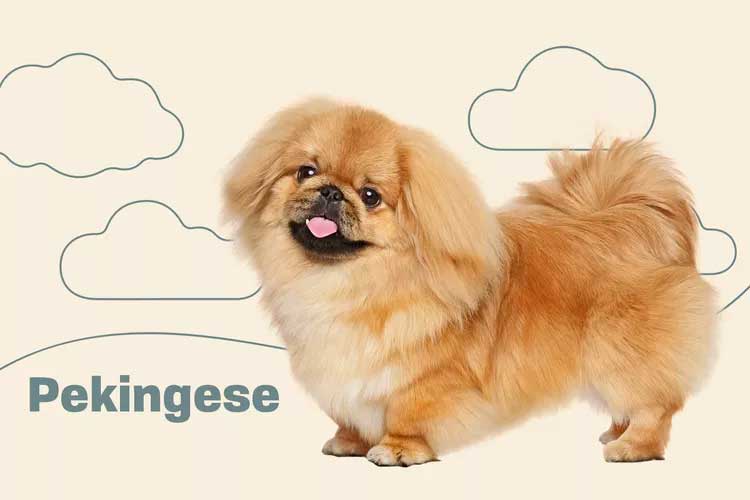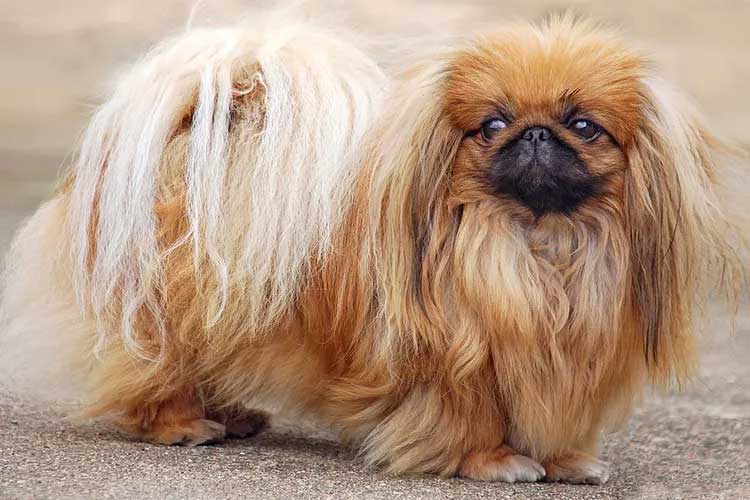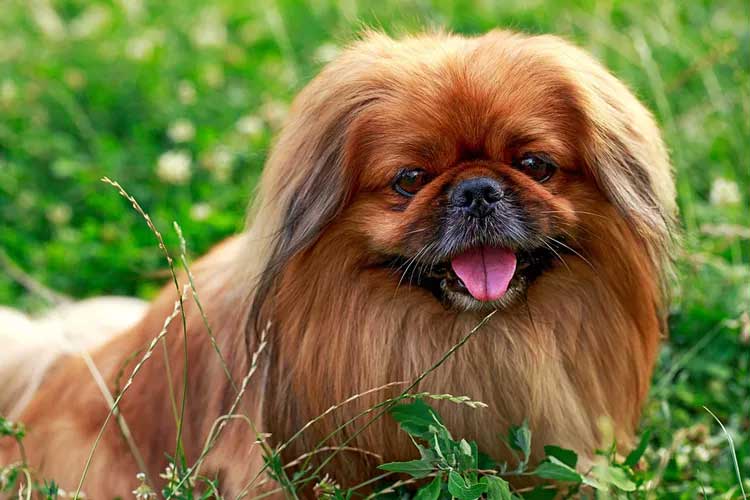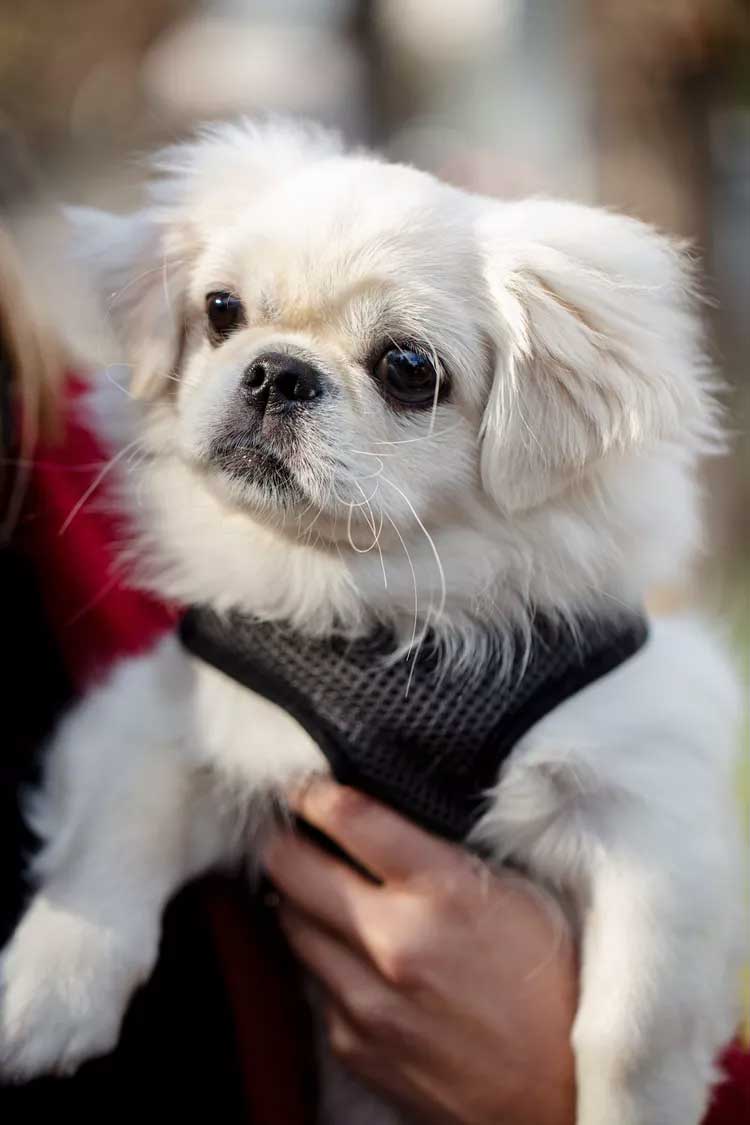Pekingese are intelligent, affectionate, and friendly. These compact lion-maned dogs were first bred as companions for Chinese emperors. Learn more about living with Pekingese.

Pekingese Overview
| OFFICIAL NAME | Pekingese |
| COMMON NAME | Pekingese |
| PET HEIGHT | 6 to 9 inches |
| PET WEIGHT | 8 to 14 pounds |
| LIFESPAN | 12 to 14 years |
| GOOD WITH | cats, children, dogs, families, seniors |
| TEMPERAMENT | aloof, friendly, gentle, willful |
| INTELLIGENCE | high |
| SHEDDING AMOUNT | seasonal |
| EXERCISE NEEDS | low |
| ENERGY LEVEL | calm |
| VOCAL LEVEL | when necessary |
| DROOL AMOUNT | low |
| BREED GROUP | toy |
| BREED SIZE | small (0-25 lbs.) |
| COAT LENGTH | long |
| COLORS | black, blue, brown / chocolate / liver, cream, fawn, gold / yellow, gray, red, white |
| PATTERNS | bicolor, black and tan, brindle, sable, tricolor |
| OTHER TRAITS | apartment-friendly, good for first-time pet owners, high potential for weight gain, prone to health issues, requires lots of grooming, strong loyalty tendencies |
Bred to live as pampered royal pets in the palaces of Chinese emperors, Pekingese (pronounced pee-kuh-neez) are lovingly referred to as "lion dogs" because of their long manes and stocky build. Initially, they may seem aloof—as though they remember their regal beginnings—but these intelligent, loving, and affectionate little dogs make loyal pets, so it's no wonder that Pekingese are so popular.
They don't need much exercise and are perfect lapdogs who crave the company of their owners. Their long mane means Pekingese do need frequent grooming to keep their glorious coats in top condition.
Appearance
Pekingese are affectionate little dogs who are perfectly sized for snuggling on their owners' laps. Reaching a maximum weight of 14 pounds and standing at 6–9 inches tall, the Pekingese is surprisingly stocky and well-muscled under all that luscious fur. Though golden coloring is most commonly associated with this breed (sometimes with a black mask), they come in almost every shade (though blue and gray are considered more rare for a Pekingese).
Pekingese have black eyes, typically, that are so dark when they are looking straight ahead that barely any white is visible. He is a brachycephalic breed, meaning he has a smooshed, flat face framed by heart-shaped ears that hang flat. Keeping a Pekingese looking his best requires grooming two to three times a week (or whenever you discover tangles), and it's important to bathe him occasionally.
Temperament
Pekingese dogs can seem aloof and maybe even a little snooty when you first meet them, but to their owners, they are smart, funny, and full of personality."Part of the appeal of this breed is that they aren't everybody's fool, but they're happy to be your own private clown," says Caroline Coile, PhD, author of Pekingese: A Complete Pet Owner's Manual. She says they're also selective about who they lavish their affections on. "They love you, they love your family and like your friends, and just tolerate everybody else. This breed makes you feel special."

This toy breed is the very definition of a lapdog and is pretty laid-back at home. However, the Pekingese is also an alert little dog and, if he senses something scary (whether that be the delivery person or a neighbor on a walk), he will sound the alarm with a persistent bark.
Pekingese get along well with cats and other dogs. "They're pretty laid-back with other animals," Coile says. They can be a great family dog, but aren't one for playing all day every day, so they may be better suited to families with older children. As with all dogs, children need to be supervised during Pekingese playtime and be taught how to properly interact with (and respect) pets.
And while they adore their family, Pekingese can be guarded when first meeting new people. Socializing your Pekingese puppy early will help him grow to be OK around strangers—and keep that bark at bay.
Living Needs
Pekingese don't need much space, as their favorite place to be is right on their owner's lap. This makes them a great dog for apartment living and a perfect companion for seniors, Coile says.Because they form such a close bond with their owner, a Pekingese can suffer from separation anxiety if left alone for too long. They're not the right breed for your household if you have to be away from them for extended periods of time.
Instead of leaving your pup at home, take him with you—his small size makes it easy. He'll never be a jogging partner, but he will like joining you for short walks around the block and riding along on errands.
"They like to go places and see things, like all dogs. But physically, they can get their exercise inside an apartment," Coile says.
Care
That long leonine mane and thick double coat require a fair bit of maintenance—at least an hour of brushing every week to remove loose hairs and prevent matting. That's OK, though, because Pekingese love being lavished with attention."These dogs don't mind sitting on your lap and being brushed. It's rather soothing for both dog and owner," Coile says.
Like all dogs, Pekingese need their nails trimmed, their ears checked and cleaned, and their teeth brushed regularly.

Pekingese don't need much exercise, though they can enjoy agility and playing games at their own pace. But mostly, they'll be happy playing with toys in the living room and then snuggling up for movie night.
Because of his independent nature and propensity for pampering, Pekingese can be difficult to train. To learn basic cues (and maybe a few tricks), you'll need to be consistent and reward your pup with positive reinforcement. (Treats help a lot, too.)
"You just have to motivate them in the right way and you can train them," Coile says. "Ultimately, they want to please you."
Health
The Pekingese lifespan averages between 12–14 years. The breed is prone to the same issues all short-faced breeds have, such as brachycephalic syndrome, which can lead to respiratory distress. Their shortened airways also mean these dogs make a snuffling noise when awake and may well snore when asleep—but this is something many Pekingese owners seem to consider cute.However, their adorable flat faces could potentially be a severe enough issue to significantly restrict the ability of the dog to breathe through his nose, says Mel Vassey, DVM, a veterinarian at Comprehensive Health Services.
"In conjunction with this, the soft palate, the roof of the oral cavity way back at the back, is frequently elongated, which can partially obstruct the opening to the trachea, or windpipe," he says. "These problems can be addressed to a degree with surgery, but it's often better to look for bloodlines where this has not been a significant issue."

Unfortunately, their brachycephaly also puts the Pekingese at increased risk for certain eye conditions.
"Shortening of the face also results in the eye sockets being a good bit shallower, making the eyes bulge forward, where they are less protected," Vassey says. "Sometimes this can be enough to keep their eyelids from closing fully, which keeps the tear film from being spread over the forwardmost point on the cornea. This increases the risk of corneal ulceration, which can become severe enough to result in loss of the eye, or at least corneal scarring, which obscures the field of vision over time." It's worth discussing potential Pekingese health issues with your vet so you know what to watch out for and can deal with any issues early on.
That characteristic Pekingese facial structure also means it's hard for them to regulate temperature, and they can easily overheat. Pekingese parents need to pay special attention to their pups during the hot summer months, restrict outdoor activity to the mornings and evenings, and make sure their dog has access to water and AC. After all, dogs don't sweat like we do, so it's up to us to keep them cool.
"You need air-conditioning in the summer, and if you're driving somewhere warm with them in the car," Coile says.
Toy breeds such as the Pekingese can also suffer from several orthopedic issues, such as patellar luxation. Vassey explains this is when the groove the patella (kneecap) ordinarily lies in is too shallow, allowing it to pop out of place.
"This can be painful, and over time it can result in arthritic change in the joint," he says. "It is, however, generally reparable with surgery."
History
The Pekingese has a long and regal history, and evidence of some version of similar-looking short-nosed dogs being bred in China can be found as far back as 200 BC, according to the Pekingese Club of America. Though, it was around 800 AD that the breeding of toy breeds became popular.Favored by Chinese emperors and those who lived in their palaces, Pekingese were bred as "sleeve dogs" small enough to fit in the wide sleeves of royal garments, and peppy enough to act as tiny guard dogs when necessary. In line with ancient Buddhist teachings, the Chinese mythology of the Pekingese is that they came about through the coupling of a lion and a marmoset—hence their lion-like appearance.
In 1860, five Pekingese were brought over to England, marking the breed's entrance to the West. The American Kennel Club recognized the dogs in 1906.
Fun Facts
A Pekingese named Sun Yat Sen was one of the dogs to survive the sinking of the Titanic in 1912.These adorable little fellows seem ready-made for internet popularity. They are all over social media, from the Instagram-famous Wonton Soup the Pekingese and Kuma (a shih tzu and Pekingese mix) to Henry the Pekingese on TikTok.
Wasabi the Pekingese won Best in Show at the 2020 American Kennel Club National Championship. The 18-month-old pup comes from a long line of championship Pekingese. He went on to win Best in Show at the 2021 Westminster Dog Show.